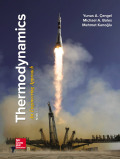
Concept explainers
A rigid tank contains a mixture of 4 kg of He and 8 kg of O2 at 170 K and 7 MPa. Heat is now transferred to the tank, and the mixture temperature rises to 220 K. Treating the He as an ideal gas and the O2 as a nonideal gas, determine (a) the final pressure of the mixture and (b) the heat transfer.
(a)
The final pressure of the mixture.
Answer to Problem 93RP
The final pressure of the mixture is
Explanation of Solution
Write the expression to caculate the mole number of
Here, molar mass of
Write the expression to caculate the mole number of
Here, molar mass of
Write the expression to caculate the total number of moles
Write the expression to caculate the partial volume of helium
Here, universal gas constant is
Write the equation to calculate the reduced temperature and pressure at initial state.
Write the expression to caculate the partial volume of helium
Here, the compressibility factor is Z
Write the expression to calculate volume of the tank.
Write the expression to calculate partial pressure at final stage.
Write the equation to calculate the reduced temperature of argon gas after mixing.
Here, temperature at final stage is
Write the equation to calculate the reduced volume of argon gas.
Here, the mole number of oxygen gas
Write the equation to calculate the pressure of argon and nitrogen gases.
Write the expression to calculate the total final pressure.
Conclusion:
Substitute
Substitute
Substitute
Substitute
Refer Table A-1, “Molar mass, gas constant, and critical2point properties”, obtain the critical temperature and pressure of oxygen as follows.
Substitue
Substitue
Refer to Figure A-15, obtain the compressibility factor for argon gas by reading the reduced temperature and reduced pressure of
Substitute
Substitute
Substitute
Substitute
Substitute
Refer to Figure A-15, obtain the reduced pressure of argon gas by reading the values of reduced temperature and reduced volume of
Substitute 0.39 for
Substitute
Thus, the final pressure of the mixture is
(b)
The amount of heat transfer into the closed system.
Answer to Problem 93RP
The amount of heat transfer into the closed system is
Explanation of Solution
Write the expression to obtain the initial and final reduced pressure of
Write the equation to calculate the reduced temperature of nitrogen gas.
Here, mixture temperature is
Write the closed system energy balance relation.
Here, input energy is
Write the expression to obtain the initial and final reduced pressure of
Write formula for enthalpy departure factor
Here, the molar enthalpy at ideal gas state is
Rearrange the Equation (XVIII) to obtain
Refer Equation (XIX) express as two states of enthalpy difference (final – initial).
Write the expression to calculate partial pressure at inital stage.
Write the expression to calculate the total inital pressure.
Conclusion:
Substitute
Refer Figure A-29, “Generalized enthalpy departure chart”, obtain the value of
Substitute
Substitute
Substitute
Substitute
Thus, the amount of heat transfer into the closed system is
Want to see more full solutions like this?
Chapter 13 Solutions
Thermodynamics: An Engineering Approach
- Correct answer is written below. Detailed and complete solution with fbd only. I will upvote, thank you.arrow_forwardCorrect answer is written below. Detailed and complete solution only. I will upvote, thank you.arrow_forwardCorrect answer is written below. Detailed and complete solution with fbd only. I will upvote, thank you.arrow_forward
- Correct answer is written below. Detailed and complete solution only. I will upvote, thank you.arrow_forwardCorrect answer is written below. Detailed and complete solution only. I will upvote, thank you.arrow_forwardCorrect answer is written below. Detailed and complete solution only. I will upvote, thank you.arrow_forward
- Correct answer is written below. Detailed and complete solution with fbd only. I will upvote, thank you. Prefferably handwritten solution pleasearrow_forwardCorrect answer is written below. Detailed and complete solution with fbd only. I will upvote, thank you. Prefferably handwritten solution pleasearrow_forwardCorrect answer is written below. Detailed and complete solution only. I will upvote, thank you.arrow_forward
- Correct answer is written below. Detailed and complete solution with fbd only. I will upvote, thank you. Prefferably handwritten solution pleasearrow_forwardCorrect answer is written below. Detailed and complete solution with fbd only. I will upvote, thank you.arrow_forwardCorrect answer is written below. Detailed and complete solution only. I will upvote, thank you.arrow_forward
 Elements Of ElectromagneticsMechanical EngineeringISBN:9780190698614Author:Sadiku, Matthew N. O.Publisher:Oxford University Press
Elements Of ElectromagneticsMechanical EngineeringISBN:9780190698614Author:Sadiku, Matthew N. O.Publisher:Oxford University Press Mechanics of Materials (10th Edition)Mechanical EngineeringISBN:9780134319650Author:Russell C. HibbelerPublisher:PEARSON
Mechanics of Materials (10th Edition)Mechanical EngineeringISBN:9780134319650Author:Russell C. HibbelerPublisher:PEARSON Thermodynamics: An Engineering ApproachMechanical EngineeringISBN:9781259822674Author:Yunus A. Cengel Dr., Michael A. BolesPublisher:McGraw-Hill Education
Thermodynamics: An Engineering ApproachMechanical EngineeringISBN:9781259822674Author:Yunus A. Cengel Dr., Michael A. BolesPublisher:McGraw-Hill Education Control Systems EngineeringMechanical EngineeringISBN:9781118170519Author:Norman S. NisePublisher:WILEY
Control Systems EngineeringMechanical EngineeringISBN:9781118170519Author:Norman S. NisePublisher:WILEY Mechanics of Materials (MindTap Course List)Mechanical EngineeringISBN:9781337093347Author:Barry J. Goodno, James M. GerePublisher:Cengage Learning
Mechanics of Materials (MindTap Course List)Mechanical EngineeringISBN:9781337093347Author:Barry J. Goodno, James M. GerePublisher:Cengage Learning Engineering Mechanics: StaticsMechanical EngineeringISBN:9781118807330Author:James L. Meriam, L. G. Kraige, J. N. BoltonPublisher:WILEY
Engineering Mechanics: StaticsMechanical EngineeringISBN:9781118807330Author:James L. Meriam, L. G. Kraige, J. N. BoltonPublisher:WILEY





